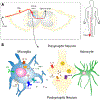Microglial Modulation as a Target for Chronic Pain: From the Bench to the Bedside and Back
- PMID: 30883419
- PMCID: PMC6788796
- DOI: 10.1213/ANE.0000000000004033
Microglial Modulation as a Target for Chronic Pain: From the Bench to the Bedside and Back
Abstract
With a widespread opioid epidemic and profound biopsychosocial implications, chronic pain is a multifaceted public health issue requiring urgent attention. The treatment of chronic pain is particularly important to anesthesiologists given our unique role as perioperative physicians and pain medicine specialists. The present review details the recent shift from a neuronal theory of chronic pain to one that includes complex neuron-glia interactions. In particular, we highlight microglia, the myeloid-lineage cells of the central nervous system, as initiators of a postinjury neuroimmune response that contributes to the acute to chronic pain transition. We discuss ever-advancing preclinical studies, wherein significant success has been made through pharmacologic and genetic modulation of microglia, and we emphasize where these approaches have made the transition to the clinical realm. Furthermore, we highlight the most current, novel efforts to visualize glial activation in vivo using positron emission tomography and improve the diagnosis of chronic pain through radiotracer binding of specific targets, like the 18 kDa translocator protein in microglia and myeloid-lineage cells. Our rapidly advancing knowledge about microglia and their involvement in pain suggests that the era of glial-targeted therapeutics is just beginning so long as we refocus our attention on optimizing preclinical studies using a clinically informed approach, before translation.
Conflict of interest statement
Figures



Similar articles
-
Central Nervous System Targets: Glial Cell Mechanisms in Chronic Pain.Neurotherapeutics. 2020 Jul;17(3):846-860. doi: 10.1007/s13311-020-00905-7. Neurotherapeutics. 2020. PMID: 32820378 Free PMC article. Review.
-
From astrocytes to satellite glial cells and back: A 25 year-long journey through the purinergic modulation of glial functions in pain and more.Biochem Pharmacol. 2021 May;187:114397. doi: 10.1016/j.bcp.2020.114397. Epub 2020 Dec 28. Biochem Pharmacol. 2021. PMID: 33382970 Review.
-
Temporal Contribution of Myeloid-Lineage TLR4 to the Transition to Chronic Pain: A Focus on Sex Differences.J Neurosci. 2021 May 12;41(19):4349-4365. doi: 10.1523/JNEUROSCI.1940-20.2021. Epub 2021 Apr 12. J Neurosci. 2021. PMID: 33846230 Free PMC article.
-
Perspectives in Pain Research 2014: Neuroinflammation and glial cell activation: The cause of transition from acute to chronic pain?Scand J Pain. 2015 Jan 1;6(1):3-6. doi: 10.1016/j.sjpain.2014.10.002. Scand J Pain. 2015. PMID: 29911589
-
The purinergic system and glial cells: emerging costars in nociception.Biomed Res Int. 2014;2014:495789. doi: 10.1155/2014/495789. Epub 2014 Sep 3. Biomed Res Int. 2014. PMID: 25276794 Free PMC article. Review.
Cited by
-
Axon Guidance Molecules and Pain.Cells. 2022 Oct 6;11(19):3143. doi: 10.3390/cells11193143. Cells. 2022. PMID: 36231105 Free PMC article. Review.
-
Rescue of Noradrenergic System as a Novel Pharmacological Strategy in the Treatment of Chronic Pain: Focus on Microglia Activation.Front Pharmacol. 2019 Sep 12;10:1024. doi: 10.3389/fphar.2019.01024. eCollection 2019. Front Pharmacol. 2019. PMID: 31572196 Free PMC article. Review.
-
Monoclonal Antibodies for Chronic Pain Treatment: Present and Future.Int J Mol Sci. 2021 Sep 25;22(19):10325. doi: 10.3390/ijms221910325. Int J Mol Sci. 2021. PMID: 34638667 Free PMC article. Review.
-
Lessons from the Analysis of a Retrospective Cohort of Patients Who Underwent Large Open Abdominal Surgery Under Total Intravenous Opioid-Free Anesthesia.Drugs Real World Outcomes. 2021 Mar;8(1):85-93. doi: 10.1007/s40801-020-00218-3. Epub 2020 Nov 24. Drugs Real World Outcomes. 2021. PMID: 33231842 Free PMC article.
-
Lack of correlation between spinal microgliosis and long-term development of tactile hypersensitivity in two different sciatic nerve crush injury.Mol Pain. 2021 Jan-Dec;17:17448069211011326. doi: 10.1177/17448069211011326. Mol Pain. 2021. PMID: 33906495 Free PMC article.
References
-
- (IOM) IoM. In: Relieving Pain in America: A Blueprint for Transforming Prevention, Care, Education, and Research. Washington (DC)2011. - PubMed
-
- Chopra N, Marasa LH. The opioid epidemic:Challenges of sustained remission. The International Journal of Psychiatry in Medicine. 2017;52(2):196–201. - PubMed
-
- Engelhardt B, Vajkoczy P, Weller RO. The movers and shapers in immune privilege of the CNS. Nature immunology. 2017;18(2):123–131. - PubMed
Publication types
MeSH terms
Substances
Grants and funding
LinkOut - more resources
Full Text Sources
Medical

